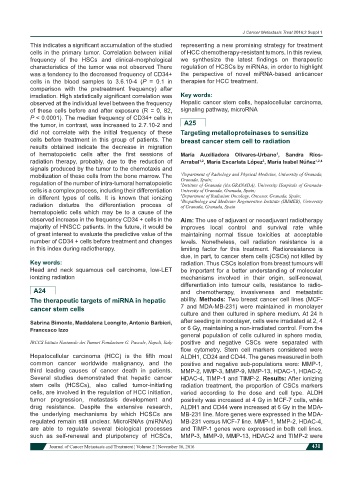Page 441 - Read Online
P. 441
J Cancer Metastasis Treat 2016;2 Suppl 1
This indicates a significant accumulation of the studied representing a new promising strategy for treatment
cells in the primary tumor. Correlation between initial of HCC chemotherapy-resistant tumors. In this review,
frequency of the HSCs and clinical-morphological we synthesize the latest findings on therapeutic
characteristics of the tumor was not observed There regulation of HCSCs by miRNAs, in order to highlight
was a tendency to the decreased frequency of CD34+ the perspective of novel miRNA-based anticancer
cells in the blood samples to 3.6.10-4 (P = 0.1 in therapies for HCC treatment.
comparison with the pretreatment frequency) after
irradiation. High statistically significant correlation was Key words:
observed at the individual level between the frequency Hepatic cancer stem cells, hepatocellular carcinoma,
of these cells before and after exposure (R = 0, 82, signaling pathway, microRNA
P < 0.0001). The median frequency of CD34+ cells in
the tumor, in contrast, was increased to 2.7.10-2 and A25
did not correlate with the initial frequency of these Targeting metalloproteinases to sensitize
cells before treatment in this group of patients. The breast cancer stem cell to radiation
results obtained indicate the decrease in migration
of hematopoietic cells after the first sessions of María Auxiliadora Olivares-Urbano , Sandra Ríos-
1
radiation therapy, probably, due to the reduction of Arrabal , María Escarlata López , María Isabel Núñez 1,2,4
1,2
3
signals produced by the tumor to the chemotaxis and
Department of Radiology and Physical Medicine, University of Granada,
mobilization of these cells from the bone marrow. The 1 Granada, Spain;
regulation of the number of intra-tumoral hematopoietic 2 Institute of Granada (ibs.GRANADA), University Hospitals of Granada-
cells is a complex process, including their differentiation Univesity of Granada, Granada, Spain;
in different types of cells. It is known that ionizing 3 4 Department of Radiation Oncology, Oncosur, Granada, Spain;
Biopathology and Medicine Regenerative Institute (IBIMER), University
radiation disturbs the differentiation process of of Granada, Granada, Spain
hematopoietic cells which may be to a cause of the
observed increase in the frequency CD34 + cells in the Aim: The use of adjuvant or neoadjuvant radiotherapy
majority of HNSCC patients. In the future, it would be improves local control and survival rate while
of great interest to evaluate the predictive value of the maintaining normal tissue toxicities at acceptable
number of CD34 + cells before treatment and changes levels. Nonetheless, cell radiation resistance is a
in this index during radiotherapy. limiting factor for this treatment. Radioresistance is
due, in part, to cancer stem cells (CSCs) not killed by
Key words: radiation. Thus CSCs isolation from breast tumours will
Head and neck squamous cell carcinoma, low-LET be important for a better understanding of molecular
ionizing radiation mechanisms involved in their origin, self-renewal,
differentiation into tumour cells, resistance to radio-
A24 and chemotherapy, invasiveness and metastatic
The therapeutic targets of miRNA in hepatic ability. Methods: Two breast cancer cell lines (MCF-
cancer stem cells 7 and MDA-MB-231) were maintained in monolayer
culture and then cultured in sphere medium. At 24 h
Sabrina Bimonte, Maddalena Leongito, Antonio Barbieri, after seeding in monolayer, cells were irradiated at 2, 4
Francesco Izzo or 6 Gy, maintaining a non-irradiated control. From the
general population of cells cultured in sphere media,
IRCCS Istituto Nazionale dei Tumori Fondazione G. Pascale, Napoli, Italy positive and negative CSCs were separated with
flow cytometry. Stem cell markers considered were
Hepatocellular carcinoma (HCC) is the fifth most ALDH1, CD24 and CD44. The genes measured in both
common cancer worldwide malignancy, and the positive and negative sub-populations were: MMP-1,
third leading causes of cancer death in patients. MMP-2, MMP-3, MMP-9, MMP-13, HDAC-1, HDAC-2,
Several studies demonstrated that hepatic cancer HDAC-4, TIMP-1 and TIMP-2. Results: After ionizing
stem cells (HCSCs), also called tumor-initiating radiation treatment, the proportion of CSCs markers
cells, are involved in the regulation of HCC initiation, varied according to the dose and cell type. ALDH
tumor progression, metastasis development and positivity was increased at 4 Gy in MCF-7 cells, while
drug resistance. Despite the extensive research, ALDH1 and CD44 were increased at 6 Gy in the MDA-
the underlying mechanisms by which HCSCs are MB-231 line. More genes were expressed in the MDA-
regulated remain still unclear. MicroRNAs (miRNAs) MB-231 versus MCF-7 line. MMP-1, MMP-2, HDAC-4,
are able to regulate several biological processes and TIMP-1 genes were expressed in both cell lines.
such as self-renewal and pluripotency of HCSCs, MMP-3, MMP-9, MMP-13, HDAC-2 and TIMP-2 were
Journal of Cancer Metastasis and Treatment ¦ Volume 2 ¦ November 16, 2016 431

